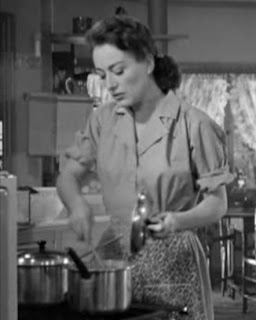Into
which Women’s Film category (Molly Haskell's four categories) would you place
Mildred Pierce? Why? (Use the Woman's Film Lecture notes for this
question).
As
soon as I reviewed the lecture film notes for the four categories I was
instantly drawn to “Sacrifice” considering everything Mildred did was for her
child Veda. She married a man she didn’t love to give her, now only, child
everything she wanted. Even before leaving her husband she was trying to give
Veda everything only to have her want more expensive, luxurious things. In the
movie Mildred says “Everything I touched turned into money, and I needed it. I
needed it for Veda.” All Mildred has tried to do is buy Veda’s love. The only
reason she didn’t sacrifice for Kay is because she already loved her mother.
Robin Morrison contends that Mildred cannot be seen as a “good mother” because
she’s working outside the home – in what ways is she shown to be a “bad
mother”? Please differentiate here between YOUR personal opinion and critical
analysis; you want to employ critical analysis and situate Mildred Pierce as a
representative icon of patriarchal structures and sexist ideologies. Try to
disengage here from what your personal beliefs are on this matter.
“A
woman cannot be an effective mother while being self-employed, for a number of
different reasons. If she is a working woman, she cannot properly take care of
her children, but also if she is a mother, her business decisions are
negatively affected by that role, and she lets consideration of her children
cloud her judgement.”
Mildred
is a “bad mother” because for women, their only job should have been taking
care of the house, children and husband.
In the movie Mildred says “I was always in the kitchen. I felt as though
I’d been born in a kitchen and lived there all my life, except for the few
hours it took to get married.”
Kathryn D’Alessandro describes how many of the visual images (cinematography,
lighting) in Mildred Pierce are reminiscent of film noir. Explain how. (You can
also refer to notes from 1940's FILM NOIR Lecture notes).
Visual / Narrative Style:
·
Majority of scenes take place at night (in the city)
·
Light falls on walls and surfaces in odd shapes
·
Use of dramatic lighting
·
Use of flashbacks and voice-over narration
·
Themes of murder, intrigue, despair, crime, corruption
·
Ending is bleak
·
Femme fatale and private detective characters
Page 5 Film Noir & Psychoanalytic Theory Lecture Notes
In the beginning of the movie it starts off with a crime scene which
then leads you to finding a character you believe is the femme fatale which
intrigues you because as the camera shows the scene of the crime it shows only Monty
dying but not the shooter thus making you believe the woman you saw is the
murderer. At certain scenes when things were more chaotic the lighting was much
darker and much more dynamic than usual.
Sybil DelGaudio defines the racial stereotype of the "Mammy" role in
the "Mammy in Hollywood" article in your course reader (also
available online). What character is shown as a racial stereotype in Mildred
Pierce? How does she fit the Mammy role?
“The
Mammy’s image is inexorably linked to either the slave-society image of
surrogate maternalism and domestic service (in the rearing and socialization of
white children), or to the pernicious myth of black matriarchy (in the sole
parenting of the fractured, father-absent black family).” - The mammy in
Hollywood film by Sybil
Lottie
is the racial stereotype in the movie, considering she fits the role of the
Mammy which is essentially a happy black woman who resembles Aunt Jemima. Lottie
is always in a happy mood always polite and up beat while working which is
essentially what they want.
Mildred Pierce is representative of a mix between the "male gaze" and
the "female gaze". Explain how, using the FILM NOIR and
PSYCHOANALYTIC Theory lecture notes as well as the web link on DEFINING THE
FEMALE GAZE. "Mildred Pierce" has ONE femme fatale. Who plays the
femme fatale and how does she fit this stereotype?
The femme fatale in this film is surprisingly the daughter Veda. Since
she was a little child she was always going on about getting money and being
rich. She is a beautiful young woman who uses her attractiveness to lure in men
to get money. An example of this would be when she married Tommy and then
divorced him to get the $10 000 financial settlement after claiming she was
pregnant. Although she has no appetite for sex, at least not outwardly, but does have a huge appetite for money and living a luxurious lifestyle.





No comments:
Post a Comment